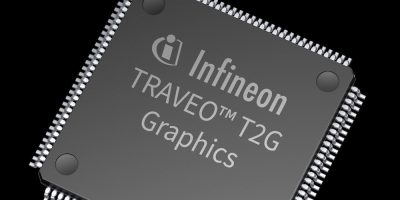Automotive MCUs have graphics engine for instrument clusters
Automotive microcontrollers (MCUs) in the Traveo T2G Cluster graphics family deliver MPU-like performance at MCU cost, said Infineon Technologies.
The automotive microcontrollers’ graphic engine features a new smart rendering technology for automotive graphics applications. It has a small footprint, enabling the MCUs to simplify OEM integration and reduce BOM costs. As a result, they are suitable for smart mobility instrument cluster and heads-up display systems for automobiles, motorcycles, and off-road mobility as well as for industrial and medical applications where quality and safety are important, advised Infineon.
The MCU family uses innovative line-based processing based on an Infineon patent, revealed the company, which enables significant line buffer savings by a factor of 10 compared to competitive devices. This results in lower power consumption, less memory needs and lower bill of materials (BoM) cost.
The devices can be combined with processors in intelligent cockpits to provide a very fast startup time, added Infineon. The graphics engine within the MCUs minimises the memory required for graphics processing by a factor of three to five, resulting in lower power consumption and lower costs. With the optimised 2.5D graphics engine, the MCUs support full virtual instrument clusters with a high resolution of up to 1920 x 1080.
Engineering samples are already available of a new T2G-C series MCU which has an LPDDR4 interface and can display complex 3D scenes. Based on up to two Arm Cortex-M7 cores with up to 320 MHz, the Traveo T2G Cluster microcontroller family enables best in class ASIL-B/SIL-2 safety performance, said the company. The MCUs have p to 6Mbytes of flash and up to 4Mbytes of internal VRAM or 1Gbyte LPPDR4 VRAM. They are also equipped with an EVITA HSM providing advanced security with hardware encryption accelerators and enhanced hardware protection with a dedicated Arm Cortex-M0+.
Packaging options range from 500-pin BGA (via 216-pin TEQFP) to 144-pin LQFP. CAN-FD, LIN, Gigabit Ethernet and CXPI are available as embedded peripherals. A JPEG decoder, video input and output and two serial memory interfaces (SPI or xSPI) are also available.
Infineon partners provide HMI tools to support the key hardware features of the microcontrollers.
The Traveo T2G CYT2CL series (Arm Cortex-M4F core at 160MHz, 4Mbyte of embedded flash), the Traveo T2G CYT3DL series (Arm Cortex-M7F core at 240MHz, 4Mbyte of embedded flash and 2Mbyte VRAM) and the Traveo T2G CYT4DN series (Dual Arm Cortex-M7F core at 320MHz, 6Mbyte of embedded flash and 4Mbyte VRAM) are available and can be ordered now.
Engineering samples of the Traveo T2G CYT4EN (Dual Arm Cortex-M7F core at 320MHz, 6Mbyte of embedded flash, LPDDR4 and eMMC interface) are also available.




